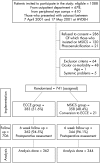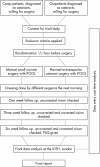Extracapsular cataract surgery compared with manual small incision cataract surgery in community eye care setting in western India: a randomised controlled trial
- PMID: 12770957
- PMCID: PMC1771720
- DOI: 10.1136/bjo.87.6.667
Extracapsular cataract surgery compared with manual small incision cataract surgery in community eye care setting in western India: a randomised controlled trial
Abstract
Aim: To study "manual small incision cataract surgery (MSICS)" for the rehabilitation of cataract visually impaired and blind patients in community based, high volume, eye hospital setting; to compare the safety and effectiveness of MSICS with conventional extracapsular cataract surgery (ECCE).
Methods: In a single masked randomised controlled clinical trial, 741 patients, aged 40-90 years, with operable cataract were randomly assigned to receive either MSICS or ECCE and operated upon by one of eight participating surgeons. Intraoperative and postoperative complications were graded and scored according to the Oxford Cataract Treatment and Evaluation Team recommendations. The patients were followed up at 1 week, 6 weeks, and 1 year after surgery and their visual acuity recorded.
Results: This paper reports outcomes at 1 and 6 weeks. 706 of the 741(95.3%) patients completed the 6 week follow up. 135 of 362 (37.3%) of ECCE group and 165 of 344 (47.9%) of MSICS group had uncorrected visual acuity of 6/18 or better after 6 weeks of follow up. 314 of 362 (86.7%) of ECCE group and 309 of 344 (89.8%) of MSICS group had corrected postoperative vision of 6/18 or better. Four of 362 (1.1%) of ECCE group and six of 344 (1.7%) of MSICS group had corrected postoperative visual acuity less than 6/60. There were no significant differences between the two groups for intraoperative and severe postoperative complications.
Conclusion: MSICS and ECCE are both safe and effective techniques for treatment of cataract patients in community eye care settings. MSICS needs similar equipment to ECCE, but gives better uncorrected vision.
Figures


References
-
- Dandona L, Dandona R, Naduvilath T, et al. Is current eye care policy focus almost exclusively on cataract adequate to deal with blindness in India? Lancet 1998;351:1312–16. - PubMed
-
- Gupta AK, Tiwari HK, Ellwein LB. Cataract survey of India: results of 1995 survey of ophthalmologists. Ind J Ophthalmol 1998;46:47–50. - PubMed
-
- El Maghraby A, Anwar M, el Sayyad F, et al. Effect of incision size on early postoperative visual rehabilitation after cataract surgery and intraocular lens implantation. J Cataract Refract Surg 1993;19:494–8. - PubMed
Publication types
MeSH terms
LinkOut - more resources
Full Text Sources
Medical
